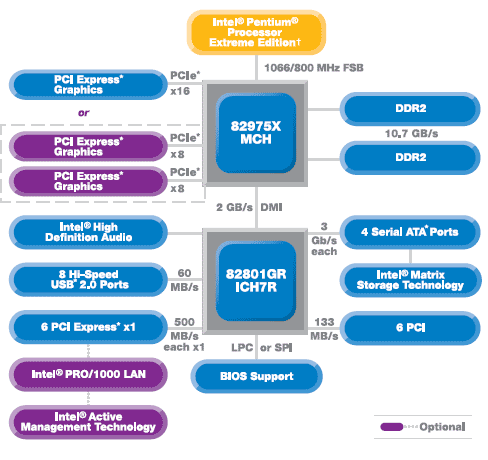Six 975X Enthusiast Motherboards for Today and Tomorrow
The 975X Chipset
The 975X chipset has been around since the beginning of the year, although there were few motherboard products on the market during its first few weeks. Technically, it is comparable to the 955X chipset, which was launched almost a year ago. Both chipsets support Front Side Bus (FSB) speeds of FSB800 and FSB1066, run DDR2-667 memory, and offer 16 PCI Express lanes. The 955X supports only one graphics slot, while the 975X supports two x16 slots each running in x8 link mode. It is nice to know that ATI's CrossFire dual graphics technology works on any 975X motherboard. FSB1066 support is required for the Core 2 Duo E6000 series, because Intel will speed up the system speed for most of the mainstream models from FSB800 to FSB1066.
975X is also the better memory overclocker than its single graphics counterpart, because its memory controller can be configured to run in synch with the FSB. This means that FSB800 can be paired with dual channel DDR2-800 memory (400 MHz), and FSB1066 even supports dual DDR2-1066 (533 MHz). However, our experience is that highest-speed DDR2 memory does not necessarily work on all motherboards, so be careful to select memory that works on your particular motherboard. In addition, not every motherboard model allows you to run the memory at this 1:1 ratio.
The chipset offers six additional PCI Express lanes, which can be configured as one x4 and two x1 slots, or as four x1 slots. There are six PCI slots and four Serial ATA ports with support for 300 MB/s transfers and Native Command Queuing (NCQ). More optical drives use Serial ATA now, making this interface increasingly important. For this reason, all motherboards in this roundup come with additional SATA controllers to add two to four more ports.
Intel has always been quick with implementing software RAID features for its integrated controllers. This also applies to the 975X as well: RAID levels 0, 1, 0+1 and RAID 5 are supported, but the really neat thing is the ability to run two different RAID arrays across one set of hard drives. You can, for example, set up a RAID 0 across two drives using only 50% of the capacity for your operating system. At the same time, you can install another RAID 1 array that you use to store your important data. Should a drive crash, the OS will be lost, but your data will still be on the second drive.
Get Tom's Hardware's best news and in-depth reviews, straight to your inbox.
Current page: The 975X Chipset
Prev Page Intel 975X Motherboard Battle, Spring 2006 Next Page Asus P5WD2-E Premium Edition
Patrick Schmid was the editor-in-chief for Tom's Hardware from 2005 to 2006. He wrote numerous articles on a wide range of hardware topics, including storage, CPUs, and system builds.
